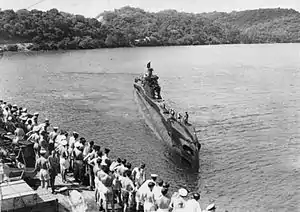 HMS Templar | |
| History | |
|---|---|
| Name | HMS Templar |
| Builder | Vickers Armstrong, Barrow |
| Laid down | 28 December 1941 |
| Launched | 26 October 1942 |
| Commissioned | 15 February 1943 |
| Identification | Pennant number P316 |
| Fate | Sunk as target 1954, scrapped July 1959 |
| Badge |  |
| General characteristics | |
| Class and type | T-class submarine |
| Displacement |
|
| Length | 276 ft 6 in (84.28 m) |
| Beam | 25 ft 6 in (7.77 m) |
| Draught |
|
| Propulsion |
|
| Speed |
|
| Range | 4,500 nmi (8,300 km; 5,200 mi) at 11 kn (20 km/h; 13 mph) surfaced |
| Test depth | 300 ft (91 m) max |
| Complement | 61 |
| Armament |
|
HMS Templar was a British submarine of the third group of the T class. She was built by Vickers Armstrong at Barrow-in-Furness, and launched on 26 October 1942 with the pennant number P316. So far she has been the only ship of the Royal Navy to bear the name Templar, probably after the crusading order, the Knights Templar.
Service
Templar served in the Far East for much of her wartime career, where she sank the Japanese merchant cargo ship Tyokai Maru and laid mines. She torpedoed and damaged the Japanese light cruiser Kitakami, and attacked the German submarine U-1062 but missed her with torpedoes.
She survived the war and continued in service with the Navy, finally being used as a target and sunk in Loch Striven, Scotland in 1954. She was salvaged on 4 December 1958 and arrived at Troon, Scotland on 19 July 1959 to be scrapped.[1]
Notes
- ↑ "HMS Templar (P316)". Uboat.net. Retrieved 13 September 2015.
References
- Colledge, J. J.; Warlow, Ben (2006) [1969]. Ships of the Royal Navy: The Complete Record of all Fighting Ships of the Royal Navy (Rev. ed.). London: Chatham Publishing. ISBN 978-1-86176-281-8.
- Hutchinson, Robert (2001). Jane's Submarines: War Beneath the Waves from 1776 to the Present Day. London: HarperCollins. ISBN 978-0-00-710558-8. OCLC 53783010.